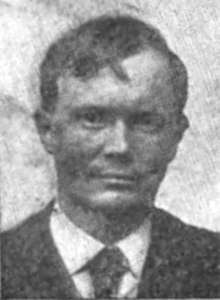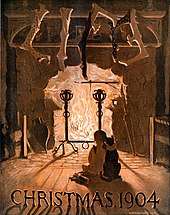William Balfour Ker
William Balfour Ker (1877–1918) also known simply as Balfour Ker, and sometimes written Balfour-Ker[1] was a Canadian-American artist whose paintings appeared in popular magazines such as Life and The Delineator, and were widely reproduced in postcards and posters. A declared socialist, some of his most popular work depicts issues of class struggle and poverty.[2] His work also appeared in advertisements for Liberty bonds and war savings stamps during World War I.
| William Balfour Ker | |
|---|---|
 | |
| Born | July 25, 1877 Dunnville, Ontario, Canada |
| Died | October 20, 1918 (aged 41) New York City, United States |
| Resting place | Rock Creek Cemetery |
| Occupation | Illustrator, painter, artist |
| Spouse(s) | Mary Ellen Sigsbee |
Early life
William Balfour Ker was born in Dunnville, Ontario, Canada on July 25, 1877.[3][lower-alpha 1] He had Scottish ancestry.[3] His mother, Lily Florence Bell Ker, was first cousin of the inventor Alexander Graham Bell,[5] and his father, William Ker, was a Scottish businessman and banker.[6][7] The family moved to the United States in 1880, where Ker was later naturalised.[5] He had two brothers who survived him.[5] Ker was raised in North Yakima, Washington,[6] and at age 18 studied law at George Washington University and began attending evening classes in illustration.[4] The Yakima Herald reported that by February 1896 he was a reporter for the Washington, D. C. Daily Post,[8] and by December 1896 was studying art in Paris.[9] He ended up as an artist in New York City.[4]
Career


Ker painted covers for Life magazine, including Thanksgiving and Christmas issues. Some of his illustrations for Life were published as postcards by the Detroit Publishing Company.[10]
Politically, he was a committed socialist, and this was often reflected in his art.[11] His most famous and most-reproduced (in the form of prints)[12]) image was From the Depths, originally published in John Ames Mitchell's book The Silent War (1906).[2][12] Copies also circulated under the name The Hand of Fate.[3] One of the former prints is held by the United States' Library of Congress.[13] According to the LoC, it depicts:[13]

a lavish social event in a large ballroom attended by the well-to-do; the party is disrupted when a fist erupts through the floor, beneath which are the struggling masses of the less fortunate who provide the foundation support on which the wealthy rest.
The People's History of Classics research project based at King's College London note that in the background of the image are:[14]
Discobolos and Venus of Melos, the two most familiar of all ancient statues, representing the decadent life of luxury
The art historian Carolyn Haynes observes:[3]
Ker clearly intended this painting to inflame class divisions between productive workers and the wealthy upper class, as represented by strong but exploited workers trapped beneath the floor and well-to-do dancers at a society ball... That such a work could be painted, published, and widely discussed suggests that class divisions in the Progressive Era were real and widespread.
During the First World War, Balfour Ker also designed posters advertising United States government war savings stamps for the United States Treasury.[15]
Personal life
Ker was married twice. His first marriage was to Mary Ellen Sigsbee,[16] a fellow socialist and a feminist,[3] whose father, Charles D. Sigsbee, had been captain of the USS Maine during the Spanish-American War.[3] The marriage was conducted against her father's wishes, after an 1898 elopement.[3] They first lived in Greenwich Village, but after a period working in Paris, the marriage failed[3] and they divorced in 1910.[16] Following their divorce, Sigsbee married Anton Otto Fischer.[17] All three were artists and former students of Howard Pyle.[17] Ker and Sigsbee had a son, David (1906–1922), who was adopted by Fischer.[17]
Ker's second wife was Josephine Reeder Phillips, an American model,[3] whom he married in England in 1914.[5] They lived there and in France, before returning to the United States.[5] They had four children, some before he divorced Sigsbee.[5] These included three sons and a daughter, Yosene Balfour Ker, who was a model featured in several paintings by the artist John Sloan,[18][19] and whose own daughter was the actress Tuesday Weld (born Susan Ker Weld).[20][21]
Ker died on October 20, 1918,[22] in New York City,[1] at the age of 41. Phillips died within a few years, leaving their four children, ranging in age from four to ten years, as orphans.[5] On discovering that they were in the care of the Society for the Prevention of Cruelty to Children in Newark, New Jersey, Alexander Graham Bell wrote to the society, and to John Adams Kingsbury in April 1922, offering assistance.[5][23]
Works illustrated
Books illustrated by Ker include:
- Lanier, Henry Wysham (1904). The Romance of Piscator. Henry Holt and Company.
- Mitchell, John Ames (1906). The Silent War. Life Publishing Company.
- Mitchell, John Ames (1910). Dr Thorne's Idea. Life Publishing Company.
- White, Bouck (1913). The Call of the Carpenter. Garden City, N.Y.: Doubleday, Page & Company.
Notes
- Some modern sources such as the Union List of Artist Names list his birth place as Dunville, Newfoundland and Labrador,[1] yet Ker himself stated in a 1911 interview: "I was born in an Imperial Bank of Canada at Dunville, [sic] Ontario, July 25, 1877."[4]
References
- "ULAN Full Record Display". Getty Research. Retrieved June 20, 2019.
- Bremner, Robert H. (1956). From the Depths: The Discovery of Poverty in the United States. New York University Press. pp. 193–194.
- Hayne, Carolyn (April 2004). "William Balfour Ker". Ask Art. Retrieved June 21, 2019.
- "Life's Family Album". Life. Vol. 58 no. 1522. December 28, 1911. p. 1182.
- "Alexander Graham Bell Autograph – Bell poignantly seeks help for children, 1922". History in Ink. Retrieved June 20, 2019.
- "Balfour Ker married". The Yakima Herald. August 17, 1899. p. 7.
- Lynx, David; Wilbur, Yvonne (November 30, 2009). "Moxee Company, The (Yakima County)". HistoryLink.
- "Local and Commercial". The Yakima Herald. February 20, 1896. p. 1.
- "Snap shots at Yakima". The Yakima Herald. December 3, 1896. p. 3.
- Broyles, Susannah (September 20, 2011). "The Age of Innocence?". Museum of the City of New York. Retrieved June 20, 2019.
- Hayne, Carolyn (April 2004). "William Balfour Ker". Ask Art. Retrieved June 21, 2019.
- "Classics & Class " From the Depths". People's History of Classics, King's College, London. Retrieved June 20, 2019.
- "From the depths / Wm. Balfour-Ker". Library of Congress. Retrieved June 20, 2019.
- "Classics & Class " From the Depths". People's History of Classics, King's College, London. Retrieved June 20, 2019.
- Ker, William Balfour (1917). "Buy United States government war savings stamps Your money back with interest from the United States Treasury /". Library of Congress. Retrieved June 20, 2019.
- "Ker, William Balfour". Schoonover Studios. Retrieved June 20, 2019.
- "Anton Otto Fischer". Illustration History. Norman Rockwell Museum. Retrieved June 20, 2019.
- Loughery, John (1997). John Sloan: Painter and Rebel (1st ed.). Henry Holt and Co. p. 298. ISBN 9780805052213.
- Elzea, Rowland (1991). John Sloan's Oil Paintings: A Catalogue Raisonné. University of Delaware Press. ISBN 978-0-87413-439-1.
- "Profile of Lathrop M. Weld". The New York Times. June 7, 1947.
- "Yosene Ker a Bride; Wed to Lathrop M. Weld in Municipal Marriage Chapel". The New York Times. January 28, 1934.
- "Balfour Ker". Greenwich Village quill v.3:6. November 1918. Retrieved June 20, 2019.
- Bell, Alexander Graham (April 18, 1922), "the children of Balf Ker", Letter to John Adams Kingsbury, retrieved June 21, 2019
External links
| Wikimedia Commons has media related to William Balfour Ker. |
| Wikisource has original text related to this article: |